What Is Link Building?
Link building is the practice of acquiring links to your website from other websites. In SEO, these links are called backlinks. Getting backlinks from high-quality sites can pass authority to your site, as well as help you rank higher in the search engine results pages (SERPs). Back-links for SEO
According to Google, an important part of identifying what pages are relevant and trustworthy is “understanding if other prominent websites link or refer to the content.”
Because of this, it’s important to consider link building when building an SEO strategy.
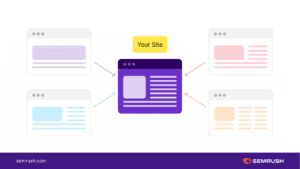
Why Is Link Building Important?
Say you have a great piece of content, but your website is fairly new and hasn’t earned much authority yet. Getting links from other trustworthy websites is a great way to help Google see your site as more authoritative.
Backlinks are essentially votes of confidence for your site.
And because pages with more backlinks often rank higher, it’s essential to:
- Create high-quality content worth linking to, and
- Use link building strategies to help bring in more backlinks
Since link building takes effort, starting the process of link building sooner rather than later will give you a bigger advantage over competitors and bring great benefits to your website in the long run.
You Might Also Like: The Professional’s Guide to SEO
How Does Link Building Work?
The best way to boost your authority through link building is to earn backlinks from credible, high-quality websites. If you have tons of backlinks but they are from spammy, irrelevant sites, they probably won’t help you rank any better.
There are many ways to acquire backlinks, including:
- Guest blogging
- Social media promotion
- Manual outreach
- Pursuing competitors’ backlinks
We’ll get into specific strategies shortly.
But keep in mind that backlinks aren’t everything—first and foremost, you should focus on creating useful, high-quality content.
When investigating ways to improve your rank, harnessing the power of link building can be a challenge for beginners and experienced professionals alike. However, it can be one of your most powerful tools for organic success.
You Might Also Like: How To Make Money on Redbubble
Three Types of Links
When planning your link-building strategy, it’s important to know the different types of links.
The most important types of links to know are below.
1. Nofollow vs. Follow
Nofollow links are typically used when you want to link to another website but don’t want to tell Google to crawl that site.
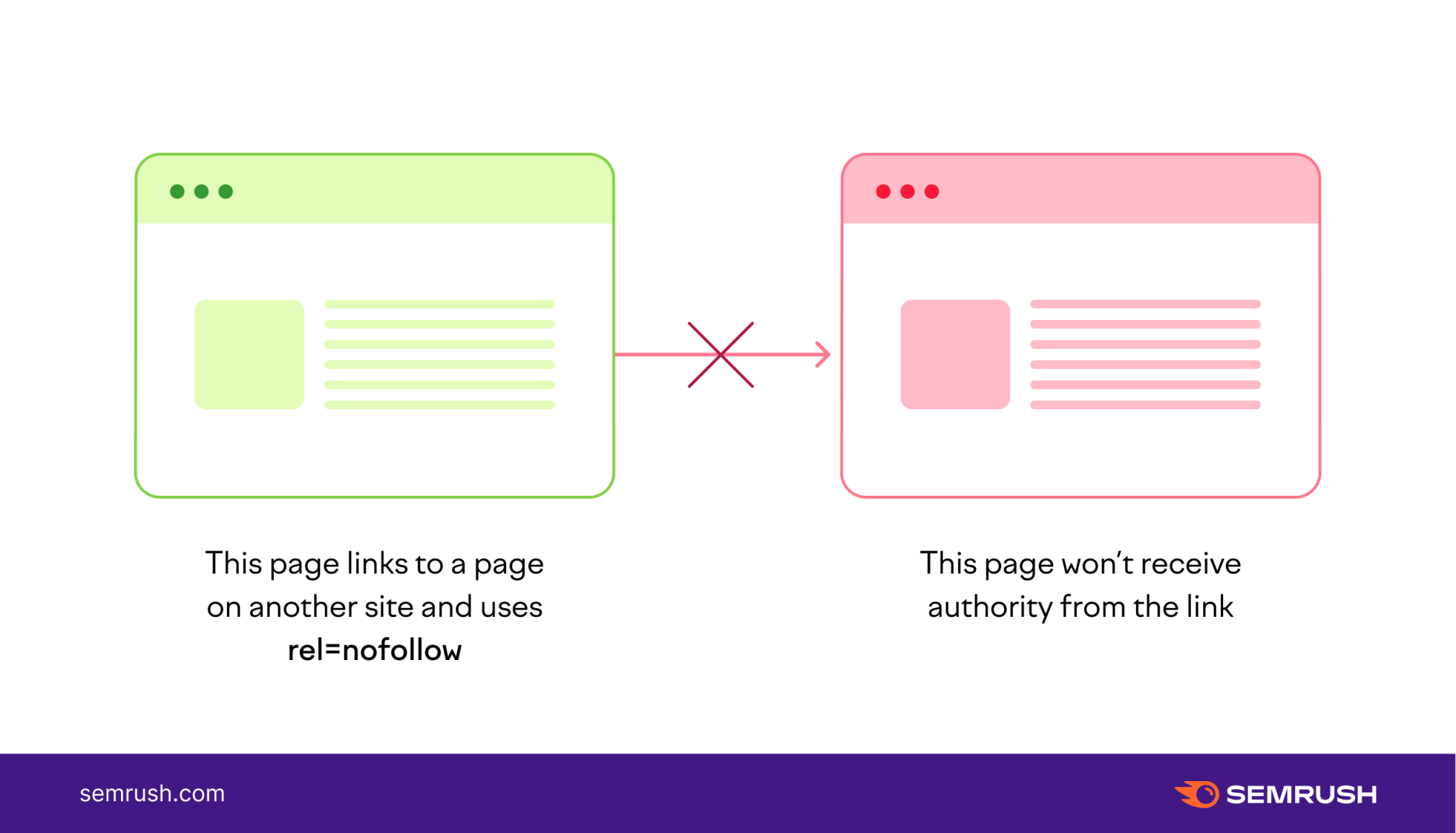
To designate a link as a no-follow link, you’ll need to add the attribute rel=”nofollow” into the link’s code. Nofollow links will inform Google that the link shouldn’t pass PageRank.
The no-follow link is helpful for two reasons:
- When you need to link to a site but don’t want to endorse it
- When the link is profitable. Google introduced rel=”sponsored” (and rel=”ugc”) as an additional type of backlink attribute, and prefers users use rel=”sponsored” for paid or profitable links (such as paid ads, banner ads, affiliate links, sponsored content) instead of rel=”nofollow”
Keep in mind, no-follow links don’t pass authority directly. However, they still can provide you with brand recognition and referral traffic.
Follow links, on the other hand, are regular links with attributes that would inform Google the link should pass PageRank.
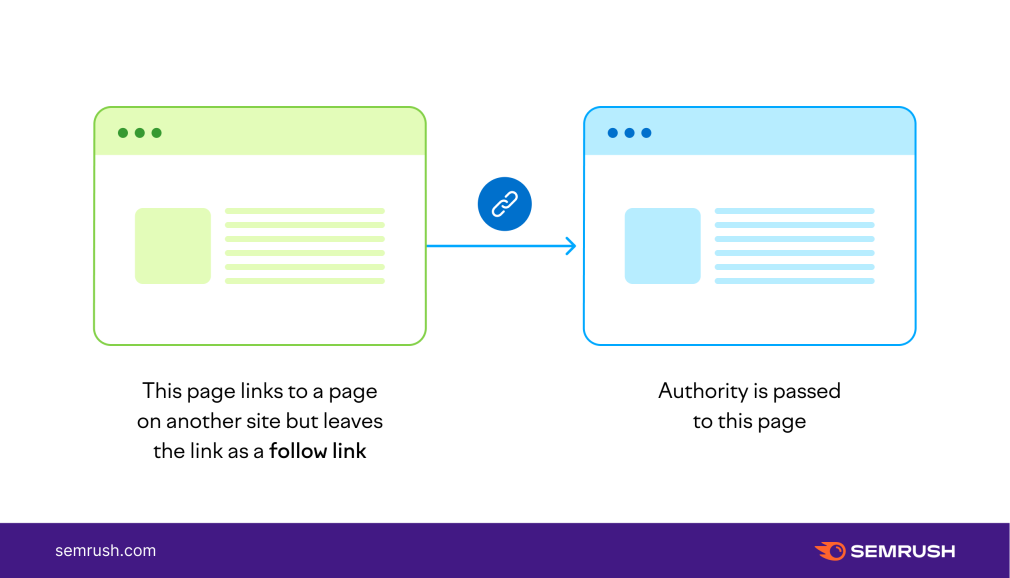
You would use a follow link if you wanted to:
- Pass on authority to a trusted website
- Help search engine bots understand what the content is about
In short: Follow links signal to Google to crawl a website while no-follow links don’t. PageRank is the metric that helps Google monitor if a link is giving another website points or not.
2. Links from Users
Utilizing user-generated links as a tactic for link building is not the ideal route when you’re looking to up your SEO strategy. In the past, Google penalized those who tried user-generated linking.
User-generated links are sometimes created by you with the intent to promote your own work. They are also generally lower in quality than other link-building methods that Google prefers.
Some examples of links from users include:
- Unmoderated blog comments
- Embedded infographics and widgets
- Profile pages of users
- Press releases or guest post signatures with heavily optimized anchor text
- Advertisements
Links from these sources won’t hurt your site, but it’s generally not a good idea to spend time on this strategy since these types of links probably won’t pass any authority.
You Might Also Like: Get the Most Out of Video Marketing
3. Natural Links From Other Blogs Or Sites
Natural links occur more organically from readers who come across your website including a link on their blog or website without being asked. With this link type, you don’t ask other webmasters or users to give you a backlink.
How to Successfully Build Links
1. Request Links
Outreach can take a lot of time and effort with little reward but can be more effective with the right tools.
If you are interested in getting a backlink from a particular website you know could help boost your website or page’s authority, chances are you will need to contact the website owner directly to make it happen.
But before you start requesting backlinks from all over the internet, keep a few things in mind:
- Links you request should be from a website relative to your niche
- Take the performance and credibility of the other website into account
- Craft a well-written email before you start contacting site owners is helpful
To find prospects and manage your campaign, you can use our Link Building Tool.
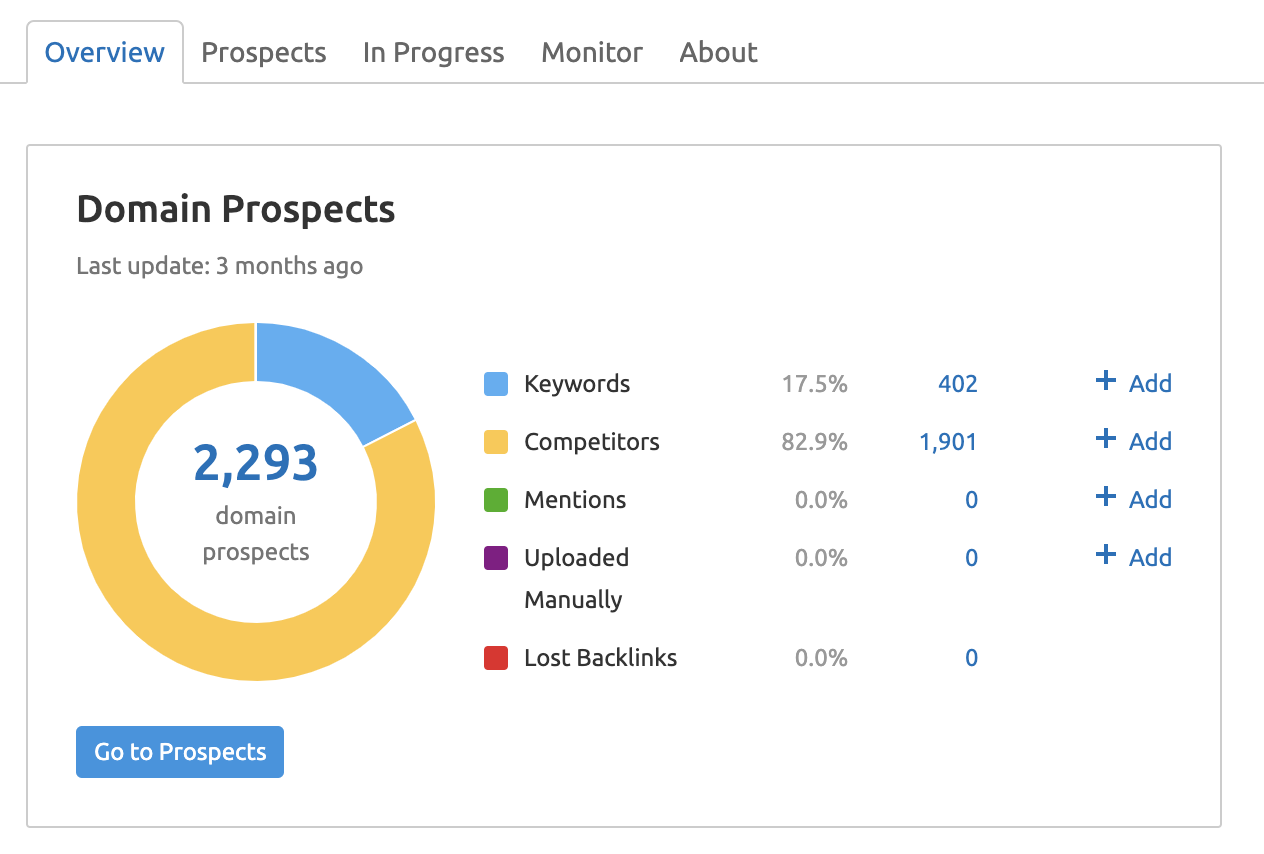
2. Manually Add Links
Manual link building refers to placing links yourself, whether that’s in a blog comment, on, a guest post on another site, or in a press release.
When adding links yourself, you’re typically in complete control of the outcome of the tactics, as opposed to relying on a journalist or other third party to link to your site.
That is precisely why these tactics are often known as “manual link building.” But keep in mind—links you are in control of usually aren’t the highest quality.
In the eyes of Google, any links that are not editorially placed are manipulative. You can manually add links editorially with intention, but it’s important not to spam links or add them randomly.
So, there’s no need to be afraid of manually adding links as long as it’s done thoughtfully.
This method of link building can drive benefits such as referral traffic or help to position you as a thought leader. It can also help you build your brand by interacting with users within your niche.
However, adding links on your own will not directly give you a significant competitive advantage. As with quick-win tactics, a strategy based around traditional link building is likely to be one that competitors can easily copy.
3. Earn Links
To gain a true competitive advantage through links, you should adopt a strategy that will allow you to earn editorially placed links.
Link earning requires a great amount of effort but gives the highest reward. So, be prepared to invest time and resources into earning links. In doing so, you will land links that competitors will struggle to replicate.
And let’s not forget that Google has been telling us for years, as part of their Webmaster Guidelines, that:
The best way to get other sites to create high-quality, relevant links to yours is to create unique, relevant content that can naturally gain popularity in the Internet community.
Creating good content pays off: Links are usually editorial votes given by choice, and the more useful content you have, the greater the chances someone else will find that content valuable to their readers and link to it.
When you earn a link, a third party actively decides to link to your website, meaning they are linking because they have a reason to. This adds value to their content and your site as a result.
You can use the Backlink Analytics tool to get an idea of what your competitors’ backlink profiles look like. Navigate to the Competitors tab to start your research and use this information to find opportunities for your own site.
Next, plug in a competitor into the tool to view the following:
- Use the Anchors Report to find the most common anchor text used in their backlinks
- Use the Referring Domains Report to see what domains are linking to their site and if they’ve recently won or lost any backlinks
- Use the Indexed Pages Report to check which pages of your competitor’s website earned the most backlinks
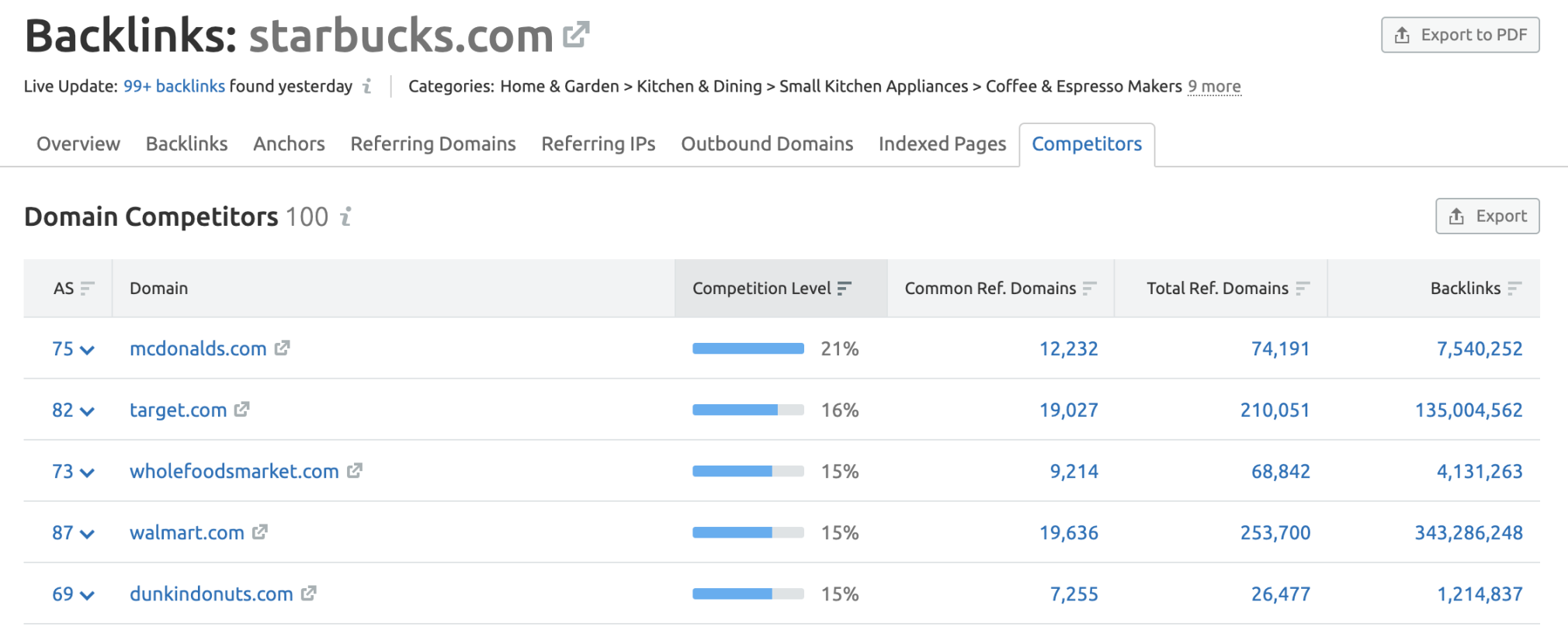
Strategies for Successful Link Building
Now for the fun part. There are many methods for proper link building, but some will prove more successful than most.
Below is a variety of methods for building healthy backlinks from quality websites.
Create Linkable Assets
Linkable assets are pieces of content meant to attract links. A common type of linkable asset is an infographic—it’s a good strategy to present original research as a graphic to those in your niche.
Additionally, creating linkable assets is a great way to build brand awareness and garner social media attention.
Infographics are about 30 times more likely to be read than a full article, so creating accompanying linkable assets can close the gap for those who don’t want to read your full piece of content.

And you don’t need to be an expert graphic designer to create linkable assets. Even if you’re starting out or don’t have the budget for creative, you can use customizable templates from sites like PicMonkey or Canva.
Linkable assets are also a gateway for referral traffic—when shared on social media, your content may reach further audiences.
Speaking of which, let’s pivot to social media as a link-building strategy.
Get Active on Social Media
An easy way to start building backlinks posting your content on social media. And once you’re armed with graphics and linkable assets, your chances of earning backlinks is likely to increase.
But don’t forget to be active on social media outside of sharing new posts, or you’ll be missing out on countless opportunities to spread brand awareness.
Even if you’re new to social media, you can get started easily:
- Post news and updates about your brand
- Engage with your audience in your comments
- Respond to brand mentions
- Participate in social media conversations within your niche

These are all good practices for increasing brand visibility on social media, which can lead to increased authority and possible backlinks.
You can also optimize your social media profiles and ensure they include the link make sure they link to your site in their bios.
Another helpful tactic is ensuring you tag brands and people of influence in your content when you talk about them. If they practice social listening, there is a good chance they will share the post or the link you shared on social media, which will help you generate a backlink from a profile other than your own.
Participate in Strategic Guest Posting
Google’s Matt Cutts announced the death of guest blogging in 2014, but is it really dead?
That’s a complex answer. The old way of guest blogging is certainly dead; it wouldn’t be a good idea to publish content on any sites that have low authority and have no relevance to your business just to get backlinks.
However, guest blogging can be a good way to earn links if done strategically.
While it’s not the most scalable tactic, it could be beneficial to partner with a company in your industry to perform a case study or present the results of joint research.
If you get requests from people charging for guest posts on their site, this is an immediate red flag. Google is far too advanced to fall for these tactics these days, so it’s best to run in the other direction.
If you do see a good opportunity for a partnership for a case study, start by reaching out directly to the site owner and pitch your idea. Outreach for guest posts may not always pan out, but it can lead to increased traffics and backlinks when done right.
Utilize Broken Link Building
Even if you don’t have the time to create new content, broken link building allows you to capitalize on content that’s already on your site.
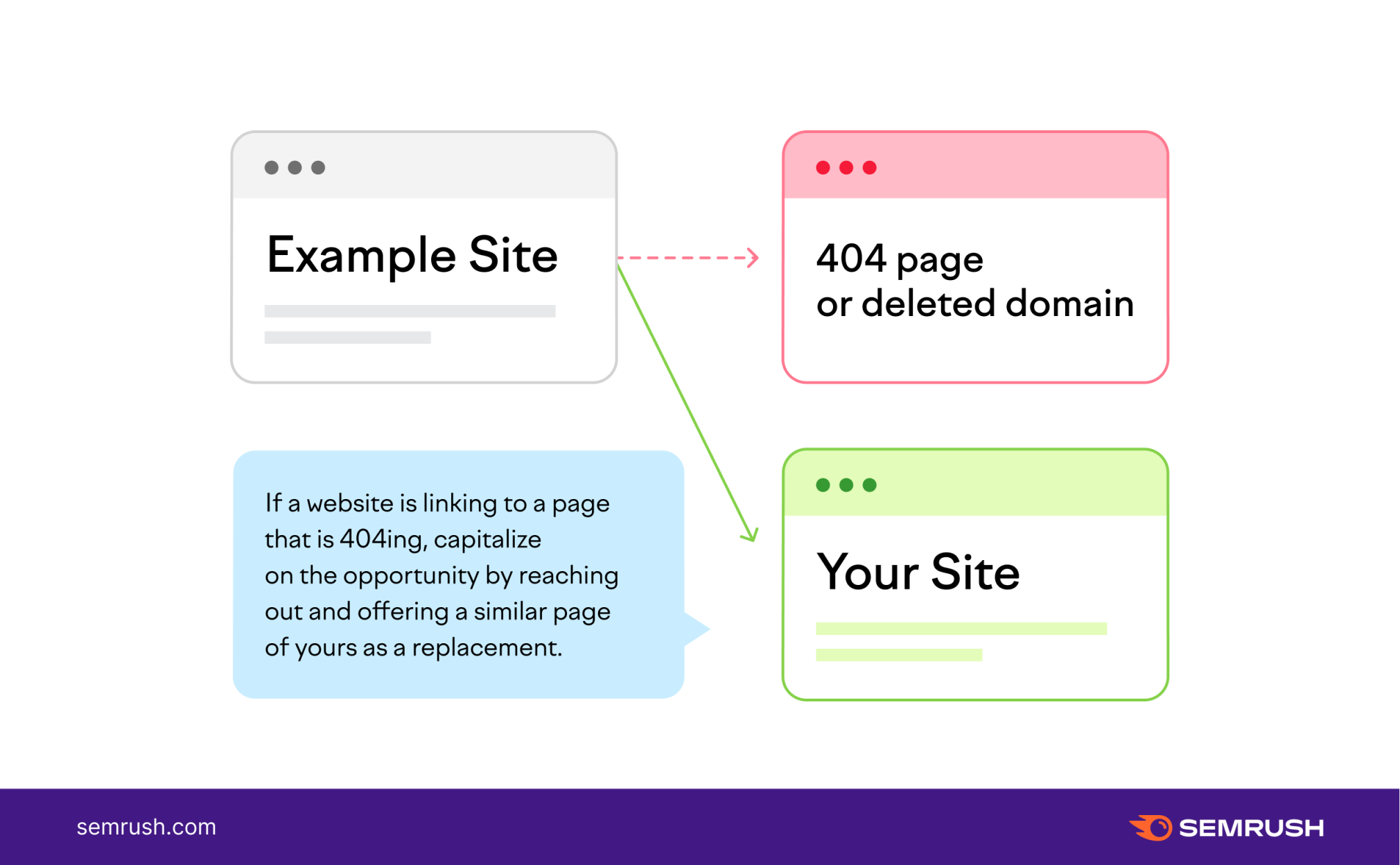
Search for broken external links on sites within your niche and reach out with a recommended piece of content from your site they can replace it with.
Start by navigating to Backlink Analytics and input a competitor’s domain.
Head to the Indexed Pages report and check “Broken Pages” on the left-hand side.
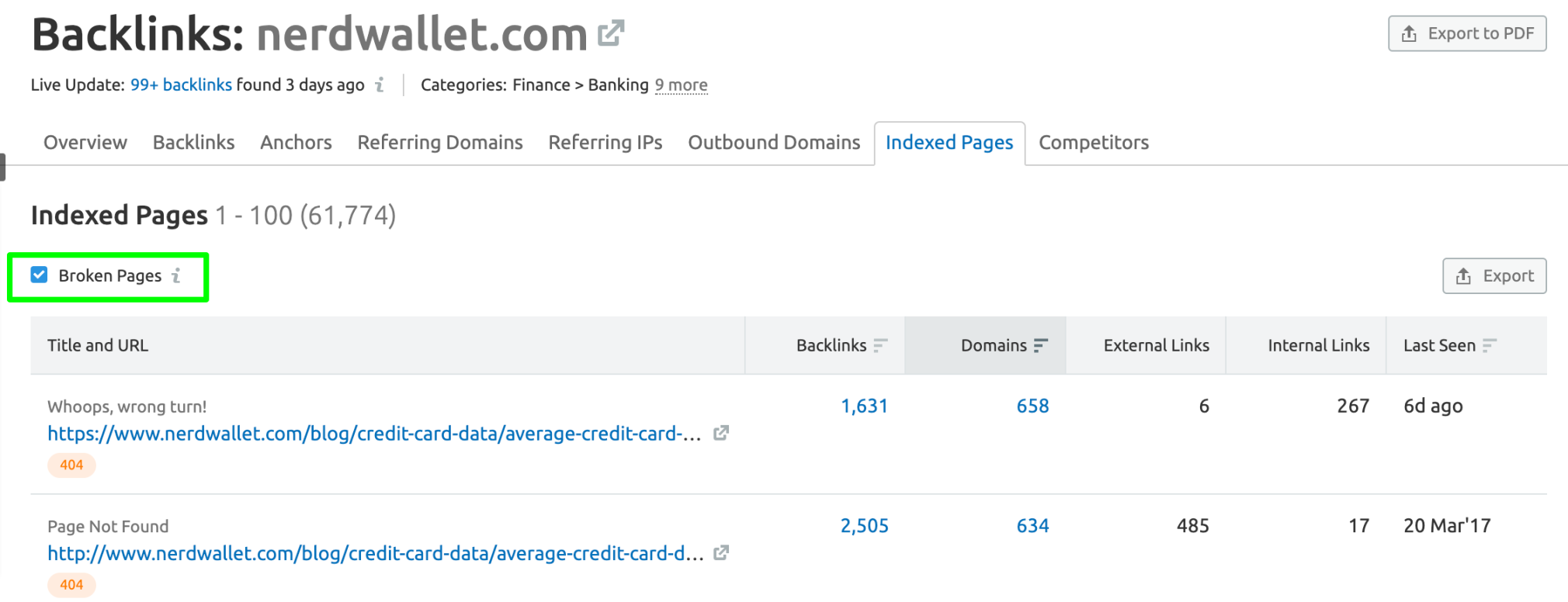
This shows you what broken pages on a particular site have backlinks pointing at them.
From here, find similar pages on your site and reach out to specific sites within your field.
Find Unlinked Brand Mentions
Many businesses find themselves mentioned in the press from time to time, with some natural references and others coming about as a result of your PR team’s efforts.
It’s not uncommon for this coverage to have no link and to just be a brand mention, but it is often easy to see this turned into a link with only minimal effort. The hard work of securing coverage in the first place has already been done.
You can find brand mentions using the Brand Monitoring tool to receive notifications whenever someone mentions you but hasn’t linked to your site.

You can then politely email the person who mentioned you and ask them to add a link in, making sure you demonstrate how the link adds value to their readers—this will help make their decision easier.
You won’t always get a link added, but for only minimal effort, those that you do manage to land with this tactic make it worth your while.
Replicate Competitors’ Backlinks
This tactic is nothing more than adopting and replicating the same link-building strategy as competitors who are winning in the world of link building. We offer an in-depth guide on reverse engineering competitors’ backlinks, but we’ll get into the basics here.
Start by navigating to the Backlink Gap tool and entering your domain and at least one of your competitors’ domains.
In the below example, you’ll see arrows pointing at the number of backlinks for competitor sites you aren’t getting backlinks from. Click the arrow to find specific sites.
If you find opportunities to pursue, click the blue “Start Outreach” button to add your findings to the Link Building tool.
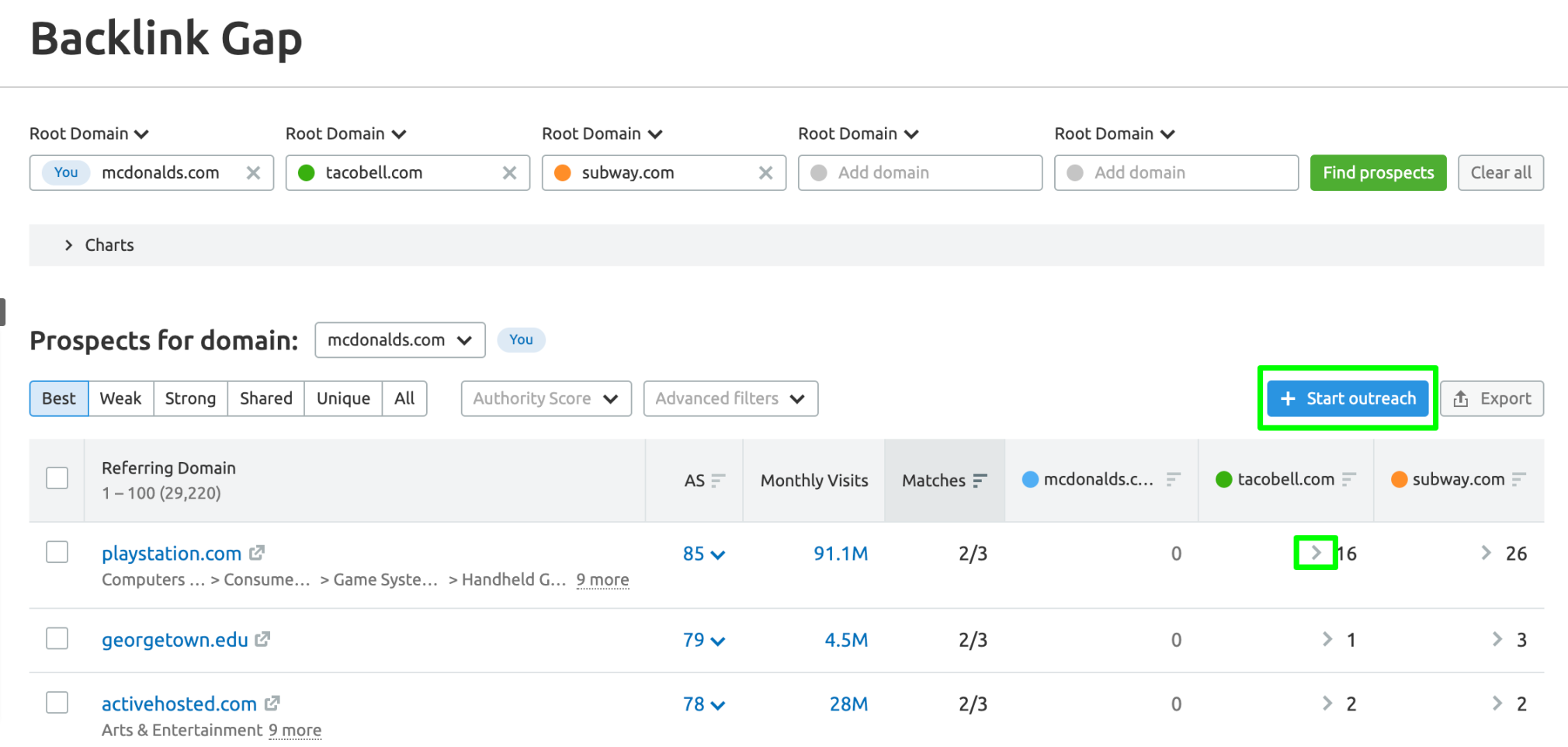
If you can analyze what a competitor is doing well with their link-building strategy, then you can use that same strategy to your advantage. You can also improve their strategy by filling in missed opportunities for acquiring backlinks.
Looking at competitors’ strategies may also help you discover how content similar to yours is performing in your niche market.
Reclaim Lost Backlinks
While it’s important to search for new link-building opportunities, it can also be helpful to keep an eye out for previous backlinks you earned but lost.
Head to the Backlink Analytics tool and click on the Backlinks report.

Select “Lost” above the list of backlinks and view the results. You can view the site you lost the backlink from as well as when you first received the link and when you lost it.
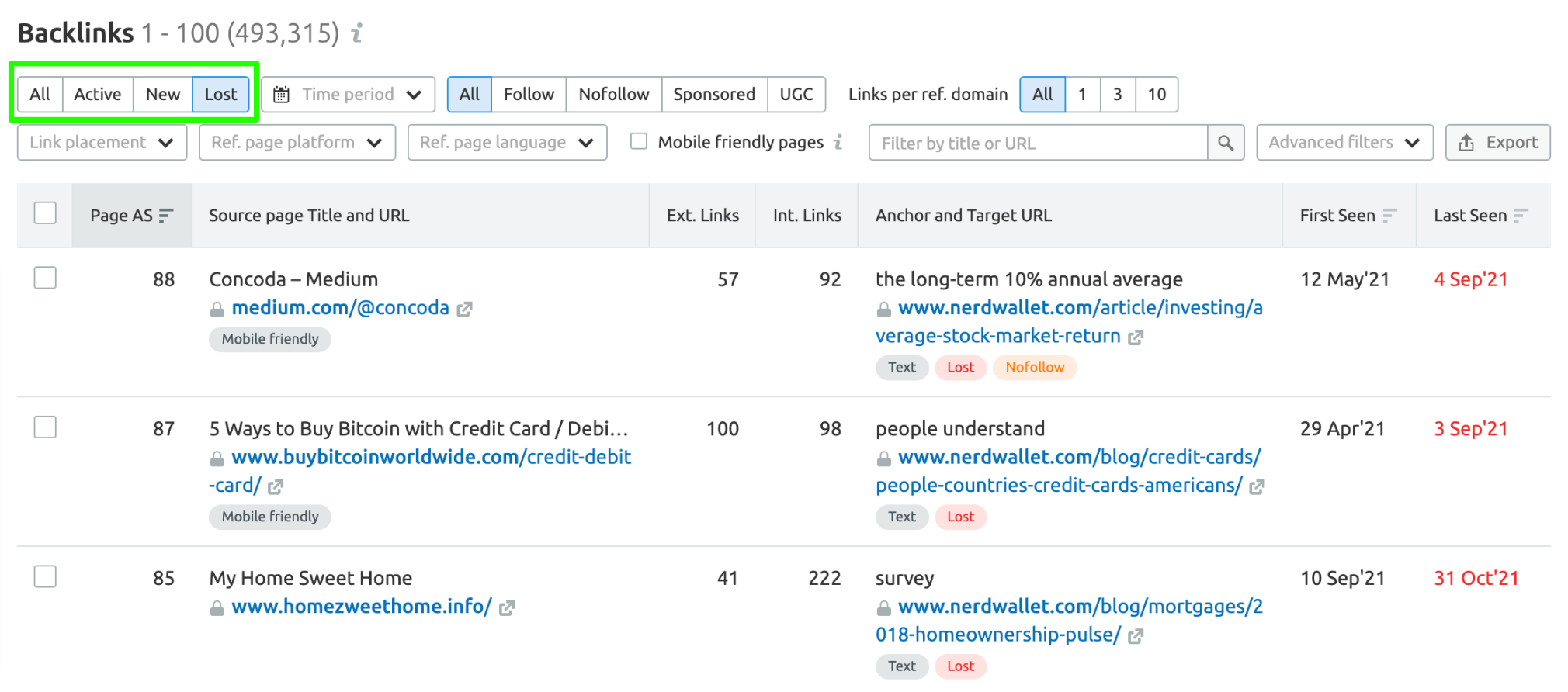
Keep in mind that sometimes you lose links because the page that linked to you was removed.
If the backlink was lost to page rewrites, you can politely reach out and suggest a spot in the content where they can place the link. Bonus points if you’ve recently updated the page with new information, as this can make the request more compelling.
There are plenty more link-building strategies to pursue, and we encourage you to try a few! We surveyed 850 SEO experts, and below you can see what they thought were the most effective ways to gain backlinks.
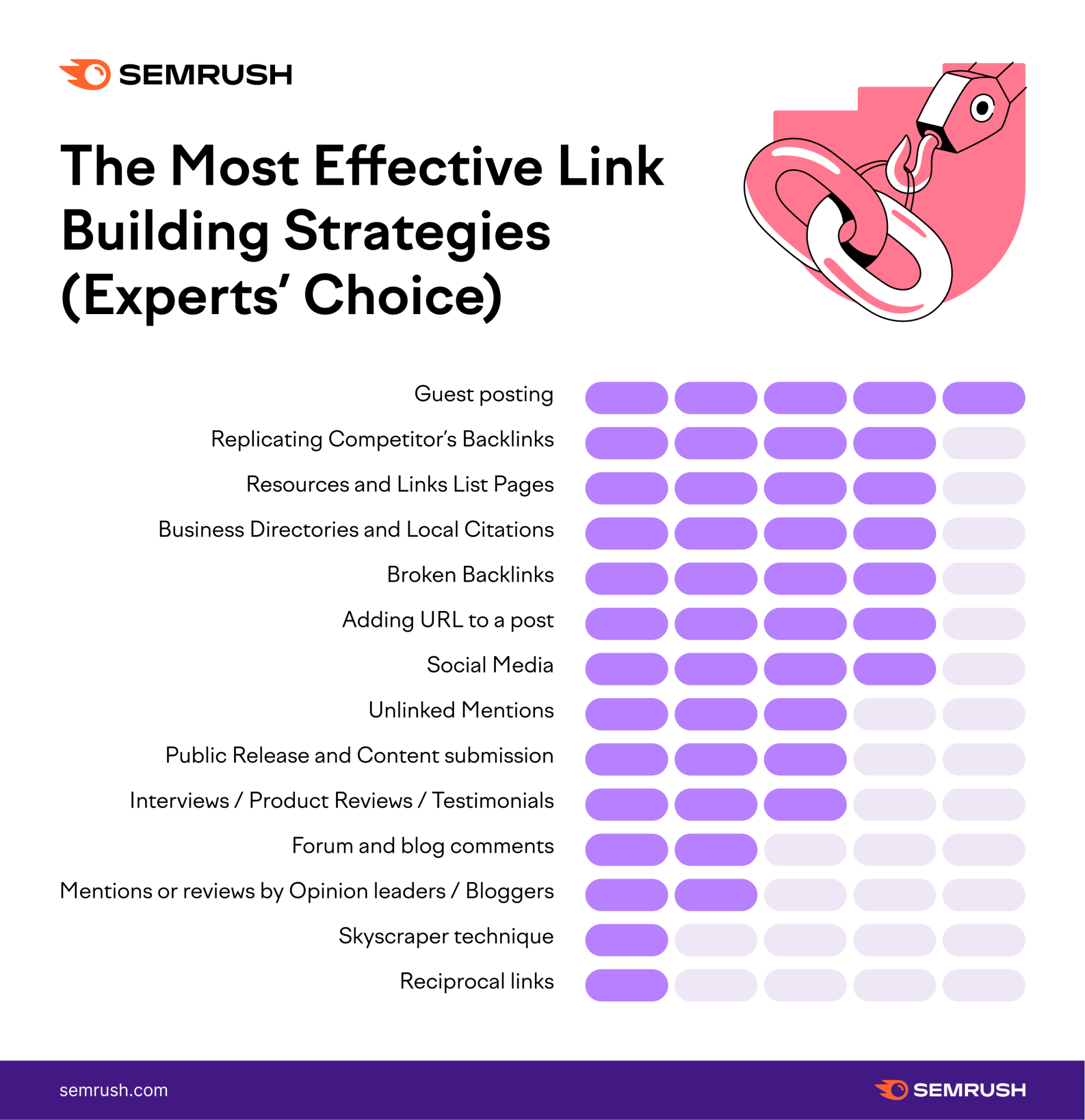
How Do You Know If a Link Is a Good Link?
With 1.88 billion websites existing on the internet, and over 25 billion indexed web pages, there are seemingly infinite links in existence.
So how can you tell the difference between a good link and a bad link?
There are five ways you will be able to tell whether the link is a good link or not.
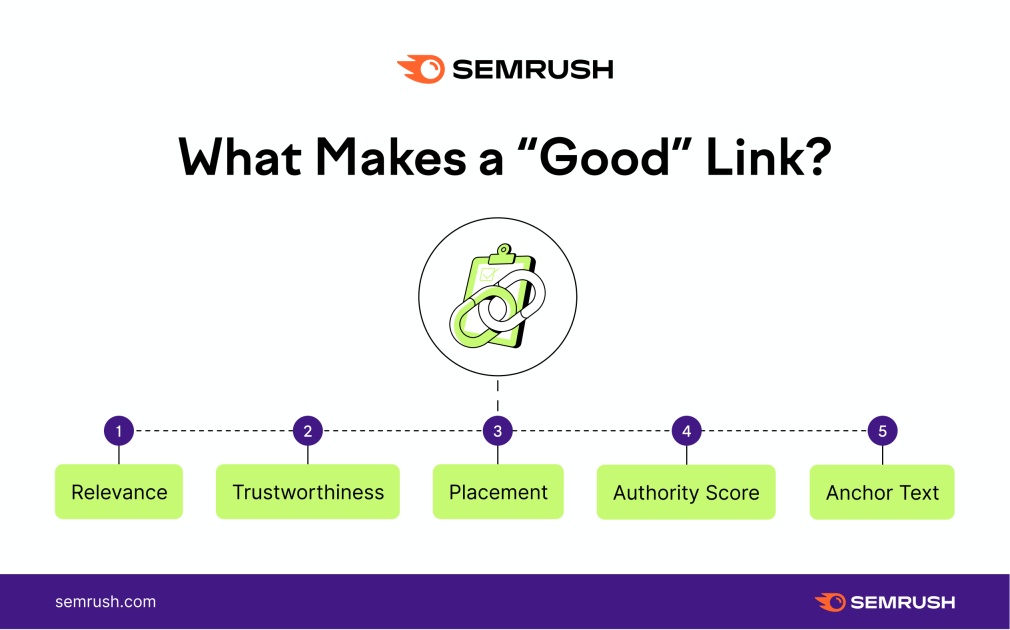
1. Relevance
Links should come from websites with content closely related to your own website’s topic. This helps to ensure you are building the right links.
When prospecting for link opportunities, get into the mindset by asking whether you would still pursue it if Google didn’t exist or use links as part of its algorithm.
If the answer is yes, this usually means it is from a topically related website where your audience hangs out online. If you would answer no, it is a good indication that the link isn’t relevant to your business.
2. Trustworthiness
There are several ways to check the trustworthiness of a website when auditing the quality of a backlink, including:
- The lifespan of the site
- If the URL contains a secure socket layer (SSL)
- Social media activity
- If a privacy policy is present
- Whether the website is biased
- The amount of traffic that reaches the site each month
Usually, if the site has been around a long time, generates a healthy amount of traffic each month, is active on social media, and has elements that indicate it’s a secure site, this is likely a good link.
3. Placement
Where you place your links is important as well as it can directly influence the visibility and performance of the link itself.
The best placements for links are in the upper body of your content.
Users are more likely to see links at the top of the page when they first land as opposed to the footer, which they may or may not reach. Try to avoid placing links in sidebars, the lower body of content, and the footer.
4. Authority Score
Authority score helps to measure how impactful a website or a domain’s links are. In most cases, the higher the weightage of your website’s Authority Score, the more trusted your domain is presumed to be.
The closer your score is to 100, on a scale of 1 to 100, the better it is. Link impact as your domain continues to grow is also based on the niche of your site.
You can check your website’s Authority Score with the Backlink Analytics tool. In addition, you can see the scores of referring domains to see how beneficial these links are to your website.
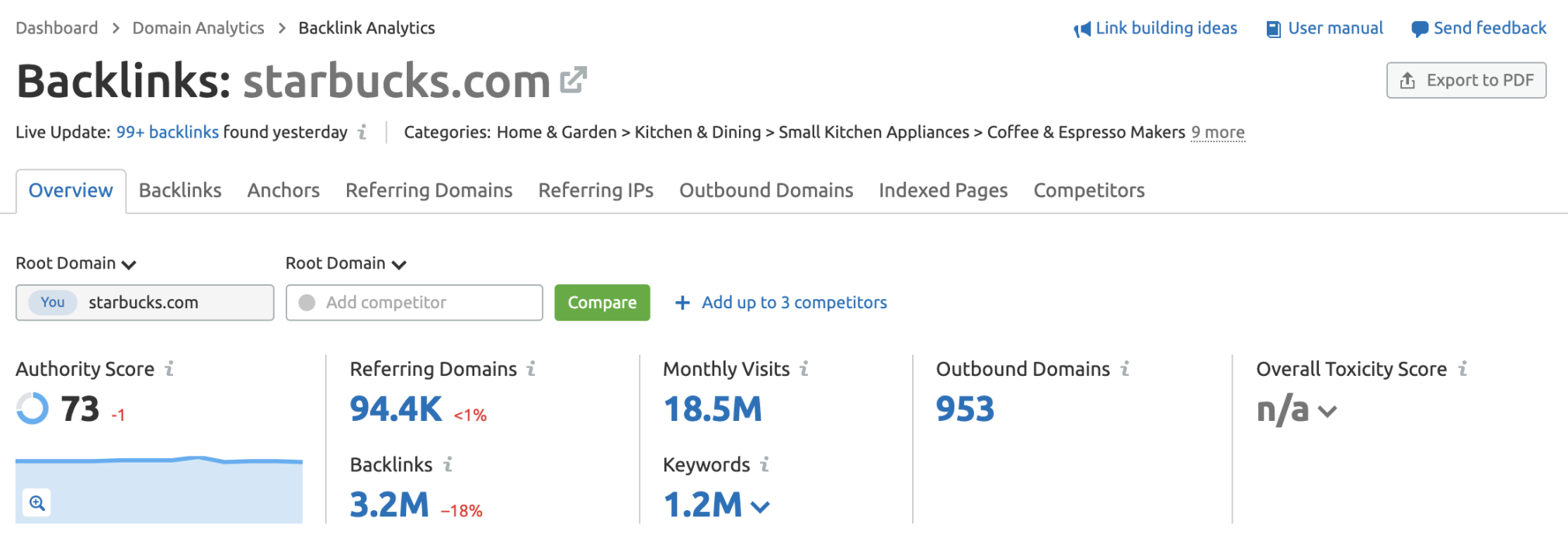
5. Anchor Text
Anchor text is the text used to link from one page to another.
While anchor text is used to help give readers context to a specific page or site, Google’s algorithm utilizes anchor text to indicate what a page is about and, therefore, can help to influence rankings.
However, Google’s guidelines state optimized anchor text (with main target keywords or commercial terms) violates their guidelines, and excessive use is a known contributor towards manual actions being applied.
Your link profile should contain a natural mix, with no apparent spike of links using optimized anchor text.
What Link Building Tactics Should I Avoid?
We’re all here to please Google’s algorithm so we can claim the top spot in the SERPs. Unfortunately, some tactics that afford you quick wins may seem nice at first, but they could negatively impact your site in the long run.
Here are some of the things you should avoid doing when link building.
Buying Links Can Backfire
Despite being a clear violation of Google’s Webmaster Guidelines and a tactic that is defined as a link scheme, paid link building is still relatively common because it guarantees results (at first).
Earning links is hard work, and there is no denying that. Even manual link building and the wealth of quick-win tactics available still require effort to see results.
These kinds of links are considered toxic backlinks, and it’s best to avoid actively pursuing these.
These days, you don’t have to worry as much if you have unwanted backlinks pointing toward your site so long as you didn’t actually participate in a link-building scheme.
However, you can use the Backlink Audit tool to keep an eye on any toxic backlinks pointing your way and even look at individual toxic markers that contribute to a link’s overall possible toxicity.

Some things to remember:
- In the opinion of many, using paid links is lazy link building
- Paid link-building manipulates Google’s algorithm and is a low effort yet extremely high-risk tactic
- Most paid-for links end up coming from sites that are not topically aligned, that have a high count of outbound links and are generally low quality
- Aside from this risk, don’t forget that if you can buy links, so can your competitors
There are, of course, a couple of exceptions to the rules:
- When earning links to support your SEO strategy isn’t the primary focus, paid link building can be used
- When you are either looking to land referral traffic or build your brand authority. This could include you sponsored placements and ads on trusted, relevant sites. And if this is the case, you should always use a rel=“nofollow” or rel=“sponsored” attribute in place to prevent a negative impact on your search rankings.
As a general rule, using paid links purely to help increase your rankings should be a no-go.
Google Penalties
If you resort to risky tactics, you risk having toxic links in your backlink profile that could get you a Google penalty and negatively affect your rankings.
It’s not unusual for it to take months, or even years, to recover from a penalty, so it’s better to be safe than sorry.
How to Measure Link Building Success
The success of a link-building campaign depends on the goals of your campaign. It’s important to understand the metrics that should be considered when setting these goals.
It’s not a great idea to focus on the raw numbers of links built as you will find that this sacrifices quality. And, you need to be using competitor insights to determine the link gap between you and others and make sure you are building the correct links that increase your rankings.
But when looking at metrics, you want to consider using one or more of the following:
- Authority Score: This Semrush metric grades the overall quality of a website, which can help you determine how impactful a backlink from a site can be. If a site has a lower authority score, it probably won’t be that beneficial.
- The ratio of Follow to Nofollow Links: It’s normal to see a mix of different types of links in your backlink profile, but generally the more follow links you have the better. Follow link are a signal to Google to pass authority to your site.
- Topical Relevance: Are your backlinks from sources closely related to your business? If you have backlinks from sites that have no relation to your business, this backlink may not carry as much weight (particularly if it’s a spammy link).
- Unique Referring Domains: Getting backlinks from a variety of high-quality sites is better than getting multiple backlinks from just one domain, even if that domain is also high-quality.
- Toxic Links: If you have any backlinks marked as “toxic” in Semrush, there’s no need to fret—Goole is smart enough to ignore these so long as you didn’t participate in a link building scheme. However, these links won’t pass any weight.
You may also want to consider goals such as brand exposure, links, and placements on certain publications, referral traffic, and more. It is all about measuring those things that matter to you as a business.
Our Best Link Building Tools
So you know what to do and what not to do when it comes to link building. Now all you need are the tools. Fortunately, Semrush has four powerful tools to help you build a healthy link-building strategy.
Those four tools are:
- Backlink Analytics: helps you quickly evaluate a backlink profile, track any domain’s backlinks, and gives insights into a competitor’s current strategies
- Backlink Audit: allows you to examine your backlink profile’s current health and status and any place where toxic backlinks might be present
- Link Building Tool: helps explore backlink opportunities, learn about the website connected to the backlink opportunity, and track the progress of the link
- Bulk Analysis: lets you upload up to 200 URLs from various competitors so you can find more chances to build links
You can learn more about these features by visiting our link-building toolkit page.
Conclusion
Like any other aspect of SEO, you will need to put in the work consistently. While link building feels like more effort is required than most SEO strategies, it will be rewarding in the end and last for the long term.
With enough persistence in implementing your link-building tactics, over time, your website may improve so much that you won’t need to work as hard for links. Instead, you can focus on developing great content that other websites and brands will want to link to.
Article courtesy of SEM Rush


